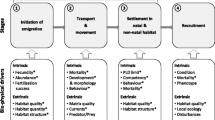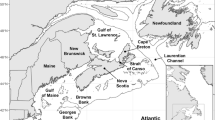Abstract
The importance of larval dispersal to the performance of marine reserve networks is widely recognized. We characterized patterns of passive dispersal in the eastern basin of the Strait of Juan, de Fuca, Washington, and interpreted the results in the context of marine reserve network connectivity. We used a surface current model to describe the dispersal of passive particles released from 16 sites over periods of 4 and 30 d in the spring of three consecutive years. We then used this approximation to infer the extent to which existing marine reseves and protected areas established on an ad hoc basis are likely to function as a network connected via larval exchange. Dispersal patterns varied substantially between release sites. Release site location accounted for the greatest amount of variation in dispersal distance, exceeding variation due to year, month, or tidal phase. After 30 d, dispersal distance and variance combined to describe three groups of release sites: those characterized by short distance, low variance dispersal; those characterized by long distance, low variance dispersal; and those characterized by intermediate to long distance, high variance dispersal. We suggest that sites within this third group are likely to make the strongest contributions to network connectivity in this system. Our findings underscore the importance of using both dispersal distance and variance estimates to model connectivity between sites and suggest that the performance of ad hoc collections of protected sites can be enhanced through the establishment of additional protected sites chosen to fill critical gaps in existing networks.
Similar content being viewed by others
Literature Cited
Beegle-Krause, C. J. 2001. General NOAA Oil Modeling Environment (GNOME): A new spill trajectory model, p. 865–871.In IOSC 2001 Proceedings, Volume 2. Mira Digital Publishing, Inc., St. Louis, Missouri.
Beegle-Krause, C. J. andC. O’Connor. 2005. GNOME Data Formats and Associated Example Data Files. Seattle: NOAA Office of Response and Restoration, Hazardous Materials Response Division. Seattle, Washington.
Crowder, L. B., S. J. Lyman, W. F. Figueira, andJ. Priddy. 2000. Source-sink population dynamics and the problem of siting marine reserves.Bulletin of Marine Sciences 66:799–820.
Csanady, G. T. 1973. Turbulent Diffusion in the Environment. Geophysics and Astrophysics Monographs, Volume 3. D. Reidel Publishing Company, Dordrecht, Boston.
Earth Science Applications Directorate Coastal Management Team. 2004. Decision Support Tool Evaluation Report for General NOAA Oil Modeling Environment (GNOME) version 2.0. National Aeronautics and Space Administration, Bay St. Louis, Mississippi.
Ebbesmeyer, C. C., C. A. Coomes, J. M. Cox, andB. L. Salem. 1991. Eddy induced beaching of floatable materials in the eastern Strait of Juan de Fuca, p. 86–98.In T. W. Ransom (ed.), Puget Sound Research 1991 Proceedings, Volume 1. Puget Sound Water Quality Authority, Olympia, Washington.
Gaines, S. D., B. Gaylord, andJ. L. Largier. 2003. Avoiding current oversights in marine reserve design.Ecological Applications 13:S32-S46.
Galt, J. A. 1980. A finite-element solution procedure for the interpolation of current data in complex regions.Journal of Physical Oceanography 10:1984–1997.
Herlinveaux, R. H. andJ. P. Tully. 1961. Some oceanographic features of Juan de Fuca Strait.Journal of Fisheries Research Board Canada 18:1027–1071.
Hickey, B. M., R. E. Thomson, H. Yih, andP. H. Leblond. 1991. Velocity and temperature fluctuations in a buoyancy-driven current off Vancouver Island.Journal of Geophysical Research 96:10507–10538.
Holbrook, J. R., R. D. Muench, D. G. Kachel, and C. Wright. 1980. Circulation in the Strait of Juan de Fuca. National Oceanic and Atmospheric Administration, Technical Report ERL 412-Pacific Marine Environmental Laboratory 33. Seattle, Washington.
Klinger, T. andC. Ebbesmeyer. 2002. Using oceanographic linkages to guide marine protected area network design.In T. Droscher (ed.), Proceedings of the 2001 Puget Sound Research Conference. Puget Sound Action Team, Olympia, Washington. Available at:http://www.psat.wa.gov/Publications/01_proceedings/sessions/sess_4a.htm
Long, E. R. (ed.). 1983. A synthesis of biological data from the Strait of Juan de Fuca and Northern Puget Sound. National Oceanic and Atmospheric Administration, Interagency energy/environment R&D program Report, EPA-600/7-82-004. Seattle, Washington.
Masson, D. andP. F. Cummings. 2000. Fortnightly modulation of the estuarine circulation in Juan de Fuca Strait.Journal of Marine Research 58:439–463.
Mofjeld, H. O. and L. H. Larsen. 1984. Tides and tidal currents of the inland waters of western Washington. National Oceanic and Atmospheric Administration, Technical Memorandum ERL PMEL-56, Seattle, Washington.
Murray, M. 1998. The Status of Marine Protected Areas in Puget Sound. Prepared for the Puget Sound/Georgia Basin International Task Force Work Group on Marine Protected Areas. Puget Sound Water Quality Action Team, Olympia, Washington.
Murray-Metcalf Northwest Straits Citizens Advisory Commission. 1998. Report to the Conveners. Washington Sea Grant, Seattle, Washington.
National Oceanic and Atmospheric Administration (NOAA). 2002. General NOAA Oil Modeling Environment (GNOME) User’s Manual. NOAA, Seattle, Washington.
Palsson, W. A. 2002. Criteria for establishing and monitoring no-take refuges for rockfish and other rocky habitat fishes in Puget Sound.In Proceedings of the 2001 Puget Sound Research Conference. Puget Sound Action, Team, Olympia, Washington. Available at:http://www.psat.wa.gov/Publications/01_proceedings/sessions/sess_4a.htm
Pashinski, D. J. and R. L. Charnell. 1979. Recovery record for surface drift cards released in the Puget Sound-Strait of Juan de Fuca system during calendar years 1976–1977. National Oceanic and Atmospheric Administration. Technical Memorandum ERL PMEL-14. Seattle, Washington.
Sauners, K. A., T. Klinger, C. A. Coomes, andC. C. Ebbesmeyer. 2004. Synthesis of 41,300 drift cards released in Juan de Fuca Strait 91975–2002).In T. W. Droscher and D. A. Fraser (eds.), Proceedings of the 2003 Georgia Basin/Puget Sound Research Conference. Puget Sound Action Team, Olympia, Washington. Available at:http://www.psat.wa.gov/Publications/03_proceedings/start.htm
Schmitt, C., J. Schweigert, and T. P. Quinn. 1994. Anthropogenic influences on fish populations of the Georgia Basin, p. 218–252.In Review of the Marine Environment and Biota of Strait of Georgia, Puget Sound, and Juan de Fuca Strait. Canadian Technical Report of Fisheries and Aquatic Sciences No. 1948. Vancouver, B.C.
Shanks, A. L. andG. L. Eckert. 2005. Population persistence of California current fishes and benthic crustaceans: A marine drift paradox.Ecological Monographs 75:505–524.
Shanks, A. L., B. A. Grantham, andM. H. Carr. 2003. Propagule dispersal distance and the size and spacing of marine reserves.Ecological Applications 13:S159-S169.
Strickland, R. A. 1983. The Fertile Fjord: Plankton in Puget Sound. Washington Sea Grant, Seattle, Washington. Available at:http://www.wsg.washington.edu/publications/online/fjord/fjord.html
Thomson, R. E. 1994. Physical oceanography of the Strait of Georgia-Puget Sound-Juan de Fuca Strait System, p. 36–100.In R. Wilson, R. Beamish, F. Aitkens, and J. Bell (eds.), Review of the Marine Environment and Biota of Strait of Georgia, Puget Sound and Juan de Fuca Strait. Canadian Technical Report of Fisheries and Aquatic Sciences No. 1948. Vancouver, B.C.
West, J. E. 1997. Protection and Restoration of Marine Life in the Inland Waters of Washington State. Puget Sound/Georgia Basin Environmental Report Series: Number 6, Seattle, Washington, Available at:http://www.psat.wa.gov/Publications/west_protect_restor.pdf
Sources of Unpublished Materials
Beegle-Krause, C. J. unpublished data. Emergency Response Division (ERD), National Oceanic and Atmospheric Administration’s Office of Response and Restoration, 7600 Sand Point Way NE, Seattle, Washington 98115-6349.
Hodges, M. 2003. Long-range oil spill trajectory research to determine the optimal mix of realtime forecasts and climatology for various temporal and spatial scales, 12th Conference on Interactions of the Sea and Atmosphere (12ISA), Seattle, Washington. Poster-paper. Available at:http://ams.confex.com/ams/pdfpapers/56095.pdf.
Jenness, J. 2005. Distance Matrix (dist_mat_jen.avx) extension for ArcView 3.x, v.2. Jenness Enterprises, Flagstaff, Arizona. Available at:http://www.jennessent.com/arcview/dist_matrix.htm.
National Oceanic and Atmospheric Administration (NOAA). 2001. User’s Guide: Strait of Juan de Fuca. Seattle, Washington. Available at:http://response.restoration.noaa.gov/book_shelf/816_Gnome_StraightJuanDeFuca_UG.pdf [April 2006].
washington State Department of Fish and Wildlife (WDFW). 1999. Washington State Marine Bathymetry Mosaic. Olympia, Washington. Metadata retrieved at:http://duff.geology. Washington.edu/data/prism/bathy/nextgen/fw.html.
Author information
Authors and Affiliations
Corresponding author
Rights and permissions
About this article
Cite this article
Engie, K., Klinger, T. Modeling passive dispersal through a large estuarine system to evaluate marine reserve network connections. Estuaries and Coasts: JERF 30, 201–213 (2007). https://doi.org/10.1007/BF02700164
Received:
Revised:
Accepted:
Issue Date:
DOI: https://doi.org/10.1007/BF02700164




